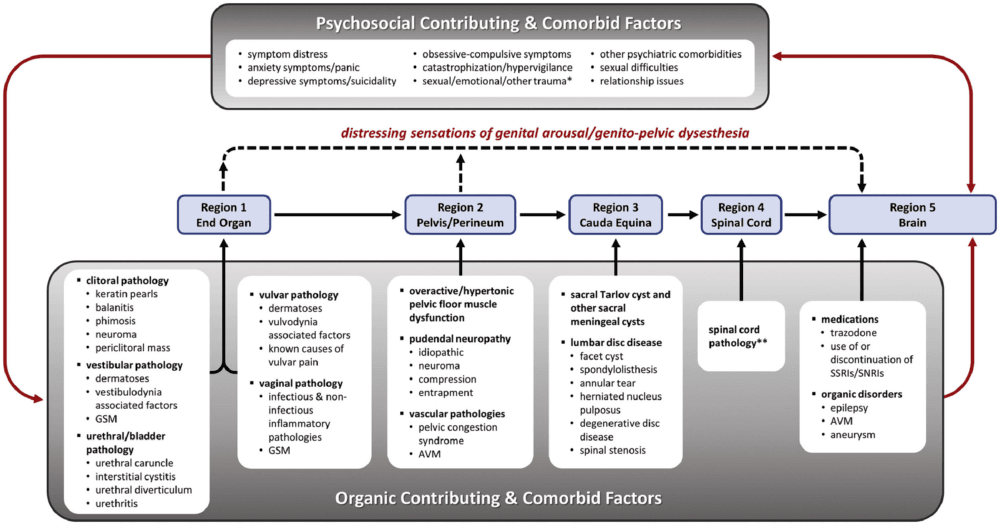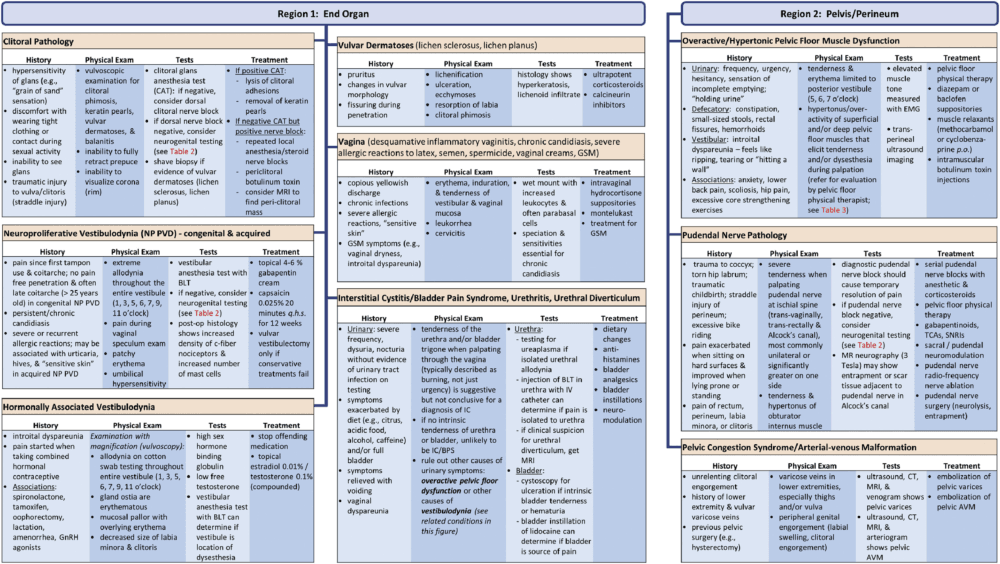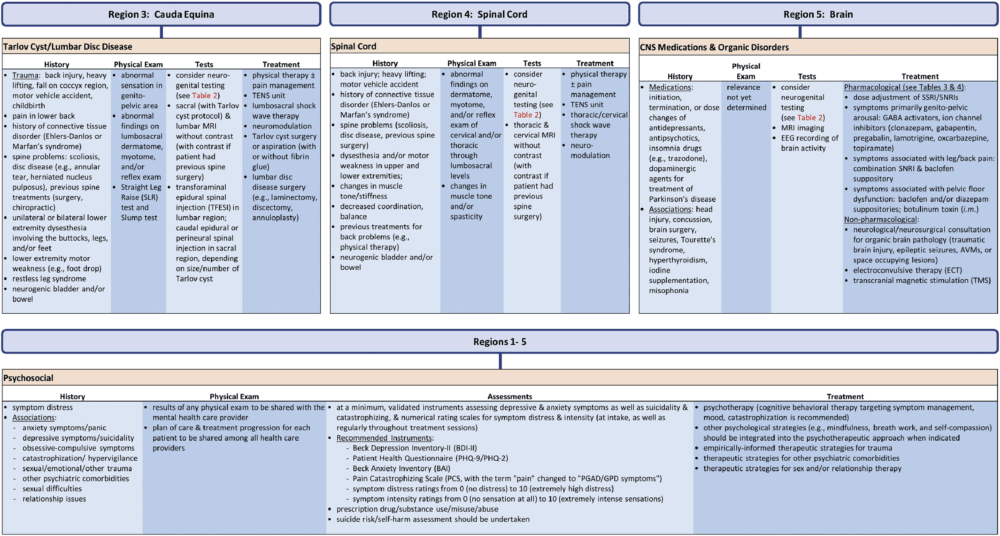Persistent genital arousal disorder (PGAD) is a condition of sexual dysfunction whereby the genitals experience unprovoked arousal, quite outside of the person’s wishes. The term genito-pelvic dysesthesia (GPD) was added in 2021, to encompass the variety of symptoms of this condition more broadly.1
The causes of PGAD/GPD are unknown.
Symptoms of PGAD/GPD
Symptoms are mostly experienced in the clitoris but can occur in the mons pubis, vulva, vestibule, vagina, urethra, perineum, bladder and/or rectum, and for diagnosis of PGAD/GPD, must be experienced for three months or longer.2
- Spontaneous genital arousal (tingling or throbbing)
- Not experienced during any sexual desire or subjective sexual arousal (i.e. nothing is sexually exciting at all)
- May persist for hours or days
- Causes high levels of distress and embarrassment
- Feeling of being on the verge or orgasm
- Uncontrollable orgasms without sexual interest, thoughts or fantasies
- Lubrication
- Swelling
- Tingling
- Throbbing
- Contractions
- Buzzing
- Burning
- Twitching
- Itching
- Pain
Theoretical causes of PGAD/GPD
Reported, suspected causes of PGAD include vascular, neurological, pharmacological and psychological. Understanding the neurophysiology of this condition starts with an understanding of the biomechanics of the pudendal nerve and female sexual response.3
If a nerve is trapped, it can result in the nerve constantly firing, resulting in continuous arousal. But, this doesn’t explain why this occurs in people who have been assessed for pelvic floor dysfunction with no findings.
Possible factors contributing to PGAD/GPD
- Psychosocial4
- Symptom distress
- Anxiety symptoms/panic
- Depressive symptoms/suicidality
- Obsessive-compulsive symptoms
- Catastrophisation/hypervigilance
- Sexual/emotional/other trauma
- Other psychiatric comorbidities
- Sexual functioning
- Relationship adjustment
- Other medical comorbidities
- Overactive/hypertonic pelvic floor muscle dysfunction
- Pudendal neuropathy
- Sacral Tarlov cyst
- Lumbar disc disease
- Annular tear
- Medications
- Trazodone
- Use of or discontinuation of SSRIs/SNRIs
Treatment of PGAD/GPD
- Osteopathy/chiropractic and musculoskeletal treatments
- Sex therapy (adjunct)
- Anti-androgen therapy5
- Hormone therapy
- Psychotherapy and other psychological strategies (eg, CBT [including decatastrophizing], mindfulness, breathwork, self-compassion, etc.)6
- Pelvic floor: sacral/pudendal neuromodulation
- Tarlov cyst surgery or aspiration (with or without fibrin glue)
- Lumbar disc disease surgery (eg, laminectomy, discectomy, annuloplasty)
- Dose adjustment of SSRI/SNRIs
- Electroconvulsive therapy (ECT)
- Holistic assessment by a qualified, experienced naturopath or functional medicine doctor (nutrition, subclinical signs and symptoms)
- Biofeedback has been suggested as a treatment option, targeting the pelvic muscles/nerves
- High-dose SSRI antidepressants may help
- Reassurance that this condition actually exists and is likely to spontaneously disappear can be very soothing and in fact, in some cases, has relieved the patient of the condition spontaneously
- Stimulation to orgasm can provide relief, at least at first, but this ‘treatment’ ceases to be effective over time. Masturbating to orgasm can be really distressing.
Diagnosing PGAD/GPD – ISSWSH guidelines
Diagnostic criteria include:
- Persistent or recurrent, unwanted or intrusive, distressing sensations of genital arousal
- Duration of ≥3 months
- May include other types of genito-pelvic dysesthesia (eg, buzzing, tingling, burning, twitching, itch, pain)
- Most commonly experienced in the clitoris but also in other genito-pelvic regions (eg, mons pubis, vulva, vestibule, vagina, urethra, perineal region, bladder, and/or rectum)
- May include being on the verge of orgasm, experiencing uncontrollable orgasms, and/or having an excessive number of orgasms
- Not associated with concomitant sexual interest, thoughts, or fantasies
PGAD/GPD is associated with:
- When examined, there isn’t overt evidence of genital arousal e.g. genital lubrication, swelling of clitioris or labia
- Limited resolution, no resolution, or aggravation of symptoms by sexual activity
- Compromised orgasm quality (eg, aversive, impaired, altered frequency, intensity, timing, and/or pleasure)
- Aggravation of genito-pelvic dysesthesia by certain circumstances (eg, sitting, car driving, music or sounds, general anxiety, stress, or nervousness)
- Despair, emotional lability, catastrophisation, and/or suicidality
- On physical examination, absent evidence of genital arousal (genital lubrication, swelling of clitoris or labia)
ISSWSH PGAD/GPD diagnostic algorithm



References
- 1.Goldstein I, Komisaruk BR, Pukall CF, et al. International Society for the Study of Women’s Sexual Health (ISSWSH) Review of Epidemiology and Pathophysiology, and a Consensus Nomenclature and Process of Care for the Management of Persistent Genital Arousal Disorder/Genito-Pelvic Dysesthesia (PGAD/GPD). The Journal of Sexual Medicine. Published online April 2021:665-697. doi:10.1016/j.jsxm.2021.01.172
- 2.Jackowich RA, Boyer SC, Bienias S, Chamberlain S, Pukall CF. Healthcare Experiences of Individuals With Persistent Genital Arousal Disorder/Genito-Pelvic Dysesthesia. Sexual Medicine. Published online April 17, 2021:100335-100335. doi:10.1016/j.esxm.2021.100335
- 3.Klifto KM, Dellon AL. Persistent Genital Arousal Disorder: Review of Pertinent Peripheral Nerves. Sexual Medicine Reviews. Published online April 2020:265-273. doi:10.1016/j.sxmr.2019.10.001
- 4.Mulroy ME, Pukall CF. Persistent Genital Arousal Disorder/Genitopelvic Dysesthesia: Review of the Current State of the Treatment Literature and Future Directions in Treatment. Curr Sex Health Rep. Published online June 7, 2023:231-243. doi:10.1007/s11930-023-00366-x
- 5.Deka K, Dua N, Kakoty M, Ahmed R. Persistent genital arousal disorder: Successful treatment with leuprolide (antiandrogen). Indian J Psychiatry. Published online 2015:326. doi:10.4103/0019-5545.166633
- 6.Facelle TM, Sadeghi-Nejad H, Goldmeier D. Persistent Genital Arousal Disorder: Characterization, Etiology, and Management. The Journal of Sexual Medicine. Published online February 1, 2013:439-450. doi:10.1111/j.1743-6109.2012.02990.x







